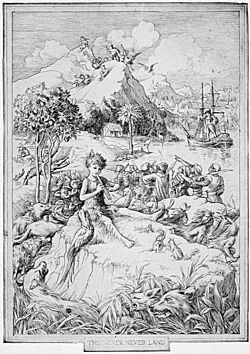Peter Pan syndrome facts for kids
Quick facts for kids Peter Pan syndrome |
|
|---|---|

Illustration of Peter Pan playing the pipes, by F. D. Bedford from Peter and Wendy
|
|
| Classification and external resources | |
| Specialty | Lua error in Module:Wikidata at line 70: attempt to index field 'wikibase' (a nil value). |
| Patient UK | Peter Pan syndrome |
Peter Pan syndrome describes when a person finds it hard to act like an adult. They might feel like they are still a child, even though their body is grown up. These people do not want to grow up or feel like they cannot. The name comes from the famous story character Peter Pan, who never gets old. While it is often linked to men, women can also experience this.
What are the signs of Peter Pan syndrome?
People with Peter Pan syndrome often find it hard to take on responsibilities. They might struggle to keep promises or commit to things. They also tend to care a lot about how they look. Sometimes, they seem very confident, but deep down, they might lack self-confidence. They may also find it difficult to have long-term relationships. When a relationship starts to need more commitment, they might become scared and end it.
People who show these signs are sometimes called Peter Panners. A professor named Humbelina Robles Ortega from the Universidad de Granada connects this syndrome to overprotective parents. She also links it to a lack of life skills. These factors can make adulthood feel very worrying for some people.
It is important to know that Peter Pan syndrome is not a recognized mental disorder. It is not listed in the Diagnostic and Statistical Manual of Mental Disorders. The American Psychiatric Association and the World Health Organization do not officially recognize it either.
Famous examples of Peter Pan syndrome
A well-known example linked to Peter Pan syndrome is Michael Jackson. He once said, "I am Peter Pan in my heart." Jackson named his large property in Los Olivos, California, Neverland Ranch. This name came from Neverland, the magical island where Peter Pan lives.
Jackson said he created Neverland Ranch to have the childhood he missed. He started performing very young with his family. At Neverland, he built many statues of children. He also had a floral clock and a petting zoo. There was a movie theater and a private amusement park. This park had cotton candy stands and two railroads. It also featured a Ferris wheel, a carousel, and other rides. These included a Zipper, an Octopus, and a Pirate Ship. There was also a Wave Swinger, a Super Slide, and a roller coaster. Kids could enjoy go-karts, bumper cars, and a tipi village. An amusement arcade was also part of the fun.
Many schoolchildren visited Neverland Ranch over the years. Michael Jackson paid for these visits. Local children and sick children from far away came to enjoy the park. Visitors often described it as a dream. A preschool teacher who visited in 2003 said Neverland "smells like cinnamon rolls, vanilla and candy and sounds like children laughing."
See also
 In Spanish: Síndrome de Peter Pan para niños
In Spanish: Síndrome de Peter Pan para niños

